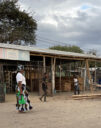Lunch! We stopped at a rest stop with a group of monkeys. We had to make a concerted effort to keep the monkeys from grabbing our food.
Nip-nops in full effect.
Festive junk also on display.
Cute baby plotting shenanigans.
While no one was paying attention, an orange was stolen.
After spending most of my lunchtime growling and pretending to be big and threatening to protect my sandwich, we headed back out for more sightings. And get ready, because I accomplished the impossible. I took good photos of not one, but TWO lilac-breasted rollers.
Gaze. Gaze at those photos and rejoice.
There was a hammerkop bird hanging out on some bird-poop-covered rocks.
Then we saw a sausage tree with a lioness in it. Bonus: She had a tracking necklace on.
She was pretty far away so I used my extremely difficult technique of holding up the binoculars to my phone to get a picture.
These I did photoshop a bit because the original looks like this:
And old dark giraffe drinking in the position where they are most in danger.
An impala looking like it’s walking across water.
Birds looking through herbivore poop for snacks.
A family of elephants coming down to the riverbed to drink. Look at the baby! He’s at least 300 pounds but he looks so cute and wee.
Far away in the distance there was a tree with another long-crested eagle.
I got such an epic cramp in my arm squished down in my seat doing my binocular technique only to realize when editing that the FREAKIN’ CREST WAS BLOCKED BY A BRANCH. The No Crested Eagle. I included the original pics along with the photoshopped ones.
I helped that I saw a black-backed jackal shortly after. It soothed my aching arm to see him trotting by.
A Von der Decken’s Hornbill.
Who went up into a tree to spend time with its mate.
Look at these red-and-yellow barbets. First of all, so pretty. So fashion. Secondly, they cock their heads to the ground to listen for grubs and bugs which looks cute as hell. It looks like they’re saying “Pardon?”
And now your doctor-recommended dik-dik of the day.
Big ole lizard. Real big. In the reeds by the river. Looked like it would be delicious grilled. Not ashamed to say it.
A pair of black-backed jackals doing whatever it is they do.
This is a great example of authentic East African clothing. A woman buys about four meters of a patterned wax resist fabric called ankara. She makes the majority of it into a skirt and with what remains she makes a headdress.
The variety of ankara fabric is amazing. I saw piles of it and never the same pattern twice. And a lot of the pieces are geometric, which I loved.
The schools are two small for all the kids so the older kids go in the morning and the younger kids go later in the day. Why that order? Well, hyenas are active in the early morning so the kids that are too big to be prey go earlier. Africa! Different to the US!
And finally, the sun setting with the Great Rift Valley. There are storks, there are guinea fowl, there are monkeys. It’s so awesome.
Coming up: The island of Zanzibar.




















































































































































